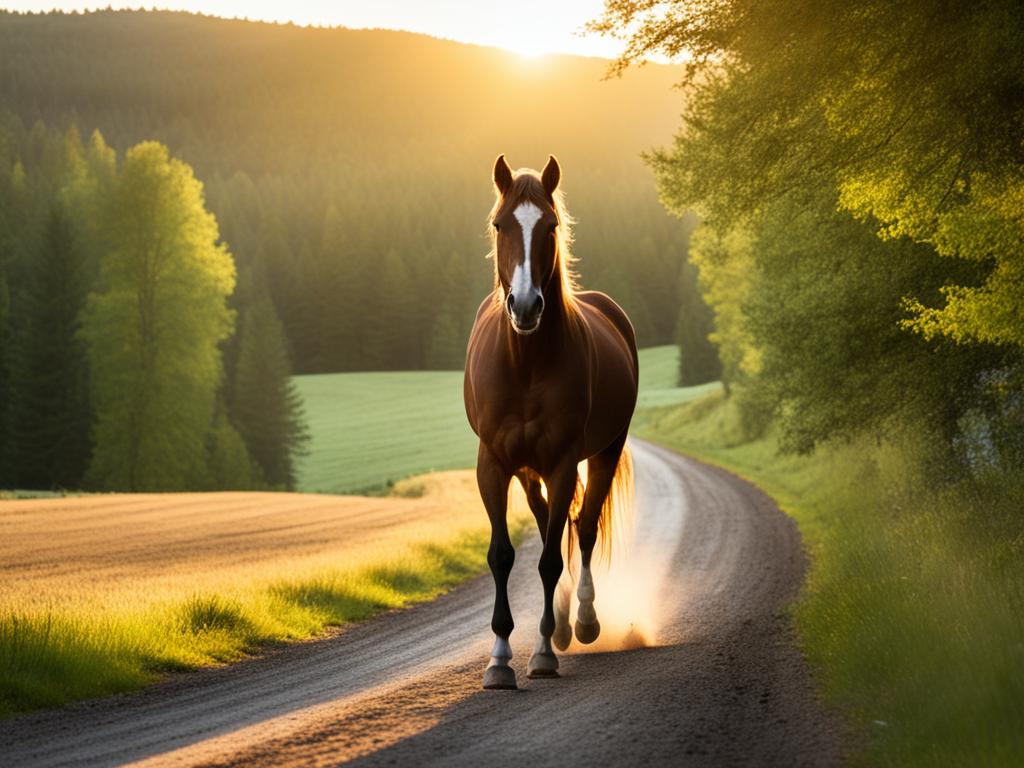Understanding the remarkable capabilities of horses in terms of daily travel distance is essential for anyone involved in equestrian activities. I’m always fascinated to learn just how far a horse can travel in a day, especially during the era of horse and buggy travel. On average, horses can trek between 25 to 40 miles daily, depending on their age, breed, and fitness level. Endurance riders have taken this to another level; they can push horses to cover up to 100 miles in one day during events, showcasing their impressive horse endurance. This historical context also reveals the critical role horses played in the past for transportation and travel, which continues to inform our understanding of horse riding distance today. Thus, knowing how far a horse can travel not only enhances our appreciation of these incredible animals but also aids in better training and conditioning practices for modern equestrian pursuits.
Table of Contents
Key Takeaways
- Average horse travel distance ranges from 25 to 40 miles daily.
- Endurance horses can reach up to 100 miles in a single day.
- Wild horses typically cover 20-40 miles daily in search of resources.
- Factors like age, breed, and fitness significantly influence horse travel distance.
- Carriage horses average between 10-30 miles within a day.
Understanding Horse Travel Distances
Exploring the vast landscapes on horseback has fascinated many for centuries. The average daily distance covered by horses varies widely based on numerous factors including health, training, and terrain. It is essential to consider these aspects when assessing how far a horse can travel in a day.
Average Daily Distance Covered
The distance a horse can cover daily largely relies on its physical condition and the type of terrain encountered. Generally, horses can traverse between 20 to 30 miles under typical conditions. Endurance breeds, like Arabians, have demonstrated remarkable capabilities, achieving distances up to 100 miles in specifically designed races. In contrast, breeds such as Quarter Horses typically align more closely with the lower end of the equestrian travel distance, often covering shorter daily distances. Proper conditioning is critical for optimal performance, with horses in peak physical shape traveling towards the higher range of 25 to 30 miles.
The horse travel speed can greatly influence distances as well. Galloping horses can reach speeds of up to 40 miles per hour, especially in short bursts. Nevertheless, it’s vital to keep in mind that horses usually perform better over longer distances when they can maintain a steady pace, and they often require regular breaks for rest, food, and water during extended rides.
Historical Context of Horse Travel
historical context of horse travel provides a narrative about transportation before modern innovations. In the past, cowhands on the open range averaged around 30 to 40 miles daily on flat land. However, rugged terrains could reduce this distance significantly to 15-20 miles. In the wild, horses generally cover 20-40 miles each day while foraging, showcasing their inherent endurance.
Traveling with lighter loads enhances their ability to cover greater distances, while heavy burdens can hinder their speed and overall daily mileage. Historical feats such as the Pony Express demonstrate the limits of horse travel, with riders covering 75 to 100 miles daily on well-conditioned mounts. Understanding these factors illustrates how important it is to take care in planning horseback journeys, especially in challenging environments.
| Horse Breed | Average Daily Distance (Miles) | Maximum Endurance (Miles) | Terrain Impact |
|---|---|---|---|
| Arabian | 25-30 | Up to 100 | Minimal on flat terrain |
| Quarter Horse | 20-25 | 30-40 | Reduced on rugged landscapes |
| Pony Express | 75-100 | N/A | Less impact with ideal conditions |
| General Horse | 20-30 | 40 | 30-50% reduction in rocky areas |
How far can a horse travel in a day
When considering how far a horse can travel in a day, it’s essential to understand the various factors influencing distance. Horses are remarkable animals capable of covering impressive ground, but certain elements determine each horse’s individual maximum riding distance.
Factors Influencing Distance
Several factors influencing distance come into play when discussing a horse’s travel capabilities. The breed of a horse is a significant aspect. Breeds like Arabians and Mustangs are celebrated for their endurance and adaptability, which enhances their maximum horse riding distance. Age also plays a role; younger and older horses may not endure long rides as effectively as those in their prime years, typically between 5 and 15 years. Overall health and fitness are crucial too. Horses that are well-trained and in top shape can cover more ground than those lacking conditioning.
Terrain significantly impacts the horse traveling range. Flat surfaces allow horses to run faster and travel farther. Hilly or rugged landscapes can slow down travel and require more rest. Weather is always a concern. Harsh conditions can limit a horse’s endurance and travel distance. Keeping these considerations in mind can lead to better planning and prevent exhaustion.
Gaits and Their Impact on Travel Distance
The speed and rhythm of a horse’s movement directly influence its travel distance. Each gait offers different speed ranges and sustainability. For example, walking allows a horse to maintain a pace of 2 to 4 miles per hour, which can be held for extended periods, making it less efficient for long-distance travel. Trotting, meanwhile, ranges from 8 to 12 mph, allowing for faster movement but might tire horses out quickly during sustained effort.
Cantering and galloping provide bursts of speed that can cover significant distances quickly. Galloping can reach speeds of 25 to 30 mph, but a horse can only maintain this for about 2 miles before fatigue sets in. An effective approach for maximizing travel distance includes alternating between these gaits based on the terrain and the horse’s stamina.

By understanding the gaits and their impact on travel distance, riders can develop strategies that optimize their horse’s performance over varying terrains. For instance, trotting periodically on a long ride allows the horse to cover more ground while managing energy efficiently. Each horse’s horse riding duration can improve significantly with balanced pacing and proper care.
Conclusion
In conclusion, understanding how far horses can travel in a day provides invaluable insights for equestrians and horse owners alike. On average, a well-conditioned horse can comfortably cover between 25 and 35 miles under ideal circumstances, while endurance horses trained for competition can exceed even 100 miles in a day. These travel distances remind us of the remarkable abilities of horses, emphasizing the significance of proper training and preparation for long-distance rides.
Several factors influence a horse’s capacity for travel, including breed, health, and the condition of equipment like saddles. It is essential to consider elements such as weather conditions and terrain, as they can greatly impact the distance a horse can travel in a day. Additionally, while horses are capable of long journeys, riders should be mindful of their own endurance, as staying in the saddle for an entire day can be a challenge.
Ultimately, the conclusion on horse travel distances highlights not only the horse’s incredible endurance but also the partnership between rider and horse. With the right approach, both can embark on enjoyable and safe adventures, appreciating the history and significance of these magnificent animals in travel and exploration.
FAQ
How far can a horse travel in a day?
On average, a horse can trek between 25 to 40 miles in a day, depending on factors like age, breed, and fitness level. Endurance horses can cover distances as great as 100 miles in a single day.
What factors influence a horse’s travel distance?
Several elements affect how far a horse can travel, including breed (with Arabians excelling in endurance), age, overall health through proper nutrition, and conditioning. Terrain and weather conditions also play significant roles.
What impact do a horse’s gaits have on travel distance?
A horse’s speed varies by gait—walking (2-4 mph) allows for longer durations, while trotting (8-12 mph) and cantering (10-17 mph) enable quicker travel but are sustainable for shorter periods. Galloping (25-30 mph) is fast but short-lived.
How does the historical context of horse travel relate to today’s equestrian travel distances?
Historically, horses were vital for transportation. Knowledge from those times helps modern horse riders understand endurance and optimize their travel distances based on terrain and conditions.
What is the maximum horse riding distance for endurance horses?
Elite endurance horses, particularly Arabians, can cover an impressive maximum of up to 100 miles in one day, showcasing their remarkable equine travel capabilities.
How does terrain affect a horse’s travel capabilities?
Flat, hard ground allows horses to maintain higher speeds and cover more distance, while rough or hilly terrain can significantly reduce how far they can travel in a day.
Why is understanding horse endurance essential for horse owners and equestrians?
Knowing a horse’s endurance helps in planning training methods and ensuring the horse is fit for longer rides, which is crucial for both rider and animal during adventures.

